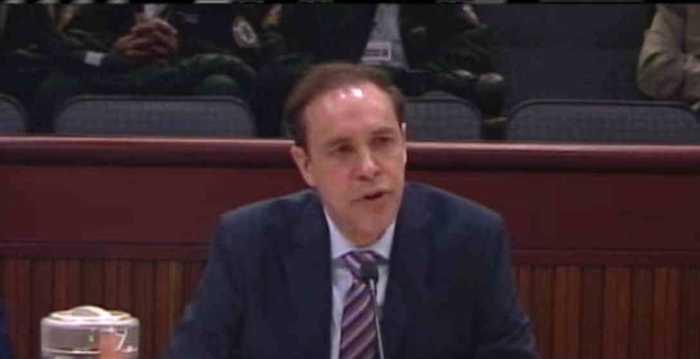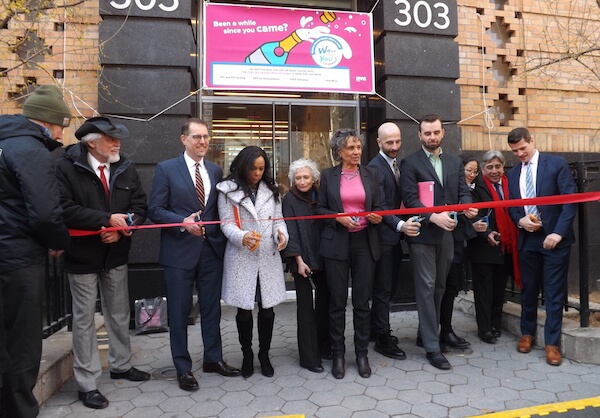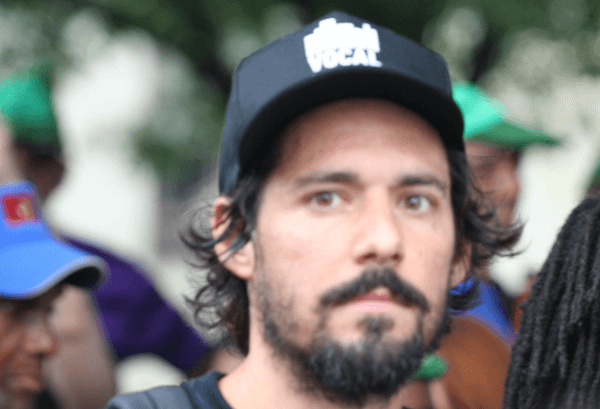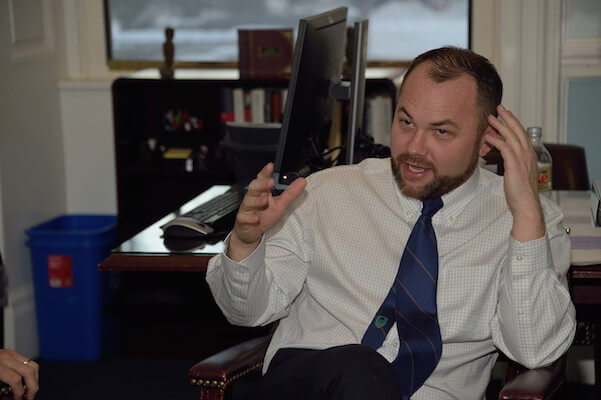PRIDE COVER PHOTO BY DONNA ACETO
Ja’asriel Bishop is a 22-year-old who came to New York from Guyana in 2016. Describing himself as “gender non-conforming or fluid,” he explained he saw no future for himself in his homeland.
“Being sexually fluid and identifying as non-binary, people there don't really know what you are,” Bishop told Gay City News this past week. “They thought I merited being beaten. I needed to get beaten.’”
Since arriving in New York, Bishop has experienced periodic homelessness, which he survived in part by couch-surfing, sometimes with friends of his Guyanese family, but also with a stint in an adult homeless shelter maintained by the city’s Department of Homeless Services (DHS).
But he only agreed to go into the shelter because he was there with his spouse. As a child, Bishop suffered abuse from members of his extended family, and he said it would be “very scary” for him go into a group home or a crisis shelter on his own. He does view supportive housing, where he could access social services, as a viable option.
Queerocracy is youth empowering themselves to transform their lives
Bishop is looking for work and hopes to build on his experience in Guyana working as a ministry’s youth consultant. Over the past several months, he has gotten involved in grassroots activism as a member of Queerocracy, a youth organizing project of VOCAL-NY — a group focused on empowering low-income New Yorkers affected by HIV, hepatitis C, homelessness, the drug war, and mass incarceration.
Bishop also became involved with the Youth Action Board, which advises the New York City Coalition for the Continuum of Care, a group made up of advocates, service providers, consumers, and government representatives who all work on combatting the city’s homelessness crisis. The YAB was recently approached by a representative of the city’s Unity Project, a multi-agency initiative announced last fall by First Lady Chirlane McCray to integrate efforts at addressing the needs of LGBTQ youth.
Bishop was among the youth recruited by the Unity Project to do paid modeling for a public service campaign the city recently rolled out in the subway system to highlight the challenges queer youth face. He stayed in touch with the Unity Project, telling them he’d like to get more involved in their efforts.
As it turned out, the Unity Project was preparing for a major announcement — on May 30 — when McCray announced $9.5 million in new initiatives focused on queer youth. In terms of planning that package of initiatives, “the work was done, I was told,” Bishop recalled. He was invited, however, to stand on stage with McCray and City Council Speaker Corey Johnson in City Hall’s Blue Room and make the event’s opening remarks.
Queerocracy members (front) Tobius Menendez; (second row) Jason Walker, Sydney Friedman, Janae’ Sumter, Ty Thomas, Daniela Arieta, (back row), Skye Adrian, Ja’asriel Bishop, and Latifah Blades. | DONNA ACETO
The program outlined that day by McCray included expanding the hours of three youth drop-in centers to 24/ 7, several efforts aimed at encouraging greater family acceptance of queer youth, a confidential foster youth population survey that will include questions about sexual orientation and gender identity and expression, and two new sites in Harlem and Central Brooklyn to facilitate PrEP access among adolescents.
And for the first time, the city committed to fund shelter beds for homeless young people 21 to 24 years old in LGBTQ-supportive facilities. Under current policy, residents at youth shelters age-out when they turn 21, and if they have not found permanent housing by then might have to face the adult shelter system, which many 21-year-olds, especially those who are LGBTQ, find dangerous. The “initial investment” in the 21 to 24-year-old beds was pegged at $1 million out of the $9.5 million, enough to fund just 20 beds.
Several hours after the event, Bishop attended Queerocracy’s weekly Wednesday evening meeting at the LGBT Community Center. There, he came to see the event he had opened earlier in the day in a different light.
“I found out the community was not engaged” in giving input into the Unity Project package. In fact, Queerocracy’s facilitators and its members were blindsided by the announcement, and several offered blunt assessments of what had transpired.
“It’s quite clear and evident that many of the funding decisions and programs piloted by this project were not informed by the faces of the young people involved with” the subway public service campaign,” said Skye Adrian, a 22-year-old Jamaican-American gay man who has been part of Queerocracy since 2015 and is the co-chair of the Continuum of Care’s YAB.
Adrian does not question that the Unity Project has “the best intentions for the LGBTQ+ community and homeless youth at large,” but he nonetheless termed the use of young people in photographs but not in brainstorming sessions, “exploitation in its most pure form.”
Others affiliated with Queerocracy offered much the same assessment.
Jason Walker, a VOCAL-NY staff member for five years who coordinates the group’s HIV work and co-facilitates Queerocracy, said of the youths’ irritation with the Unity Project announcement, “You can find young people to be in media campaigns but not to give input.”
Walker’s co-facilitator, Janae’ Sumter, said of McCray, “You are a queer black woman. Why aren’t you using that platform for us? She may have been sincere, but the way they went about it was wrong.”
Queerocracy’s pique was not simply a quibble over process; at the group’s June 13 meeting, they offered a comprehensive critique of the Unity Project’s funding priorities. At the top of the list was the relatively modest allocation for new 21 to 24-year-old beds. Both advocates and the City Council, which earlier this year mandated that the Department of Youth and Community Development take action to provide housing to this group, had requested $5 million, enough for 100 beds.
Queerocracy had plenty of company in this complaint. Widespread criticism from advocates and service providers gave Speaker Johnson leverage to push that spending commitment up from $1 million to $3 million in the budget agreement he announced with Mayor Bill de Blasio on June 11 — splitting the difference between the administration’s initial offer and what homeless youth advocates were seeking.
The visibility Queerocracy brought to itself in the skirmish over the 21 to 24-year-old beds allocation gave it an entrée into the mayor’s inner circle, which held a meeting with the group and members of the Continuum of Care YAB (membership in the two overlap significantly) on June 18, where other significant concerns were aired.
According to Walker, the meeting “was just the first conversation with the Unity Project. Our members expressed their frustrations and concerns, which were received well and they are open to discussing with us and creating ways to more meaningfully engage LGBTQ youth.”
Skye Adrian, a Queerocracy member who also co-chairs the Youth Action Board at the New York City Coalition for the Continuum of Care. | COURTESY OF SKYE ADRIAN
Adrian offered a more detailed summary of the meeting — and a less diplomatic takeaway.
Queerocracy members appreciate the need to encourage greater family acceptance of queer youth, but Adrian pointed to statistics indicating that most homeless queer youth in New York migrated here from upstate, out of state, or from abroad. Efforts like this, he acknowledged, are constructive but they are “not the most important issue.”
Two significant matters continued bothering Adrian even after this week’s sit-down with mayoral staff. The first relates to the target population for the new 21 to 24-year-old beds. As the city has dramatically increased the stock of emergency shelter beds for youth 20 and younger in recent years, there has been a concerted and successful drive to establish specific facilities for LGBTQ young people, who often face violence in more general and larger congregate settings.
“It came to my attention that the proposed shelter beds are not specific to LGBTQ-identified young people but will be ‘inclusive’ of that community,” Adrian said. “The youth that were featured in this project all identify along the LGBTQ+ spectrum, so, therefore, it sends the wrong message that this program was specific to that community, when that’s not the case.”
He added, “Not cool!”
Adrian was also disappointed regarding another one of Queerocracy’s goals — the establishment of a youth jobs and skills-building initiative.
“It was brought to my attention that the plan to pilot an Employment Initiative for young people was shut down by some ‘higher power’ when the Unity Project was being created,” he said, adding, “I have all intentions of finding out who.”
Despite his blunt critique of the $9.5 million plan’s priorities, Adrian is an activist who stays the course, and in a follow-up email to Gay City News emphasized, “As it regards the Unity Project, there is room for growth and they did mention that they will make changes to accommodate our recommendations… We are working with Unity Project for the betterment of homeless youth.”
The degree to which the Unity Project’s current plans differ from Queerocracy’s priorities means a busy and challenging agenda ahead, but in speaking to its members it quickly becomes clear that the group’s significance goes beyond its very substantial policy engagement.
Tye Thomas is a 16-year-old gay Jamaican who came to the US at 14 to attend boarding school, but also to escape a family who did not understand him and a culture of violence that victimized him. He left school after one year, and has since been staying with different members of his extended family, first in Brooklyn and now in Queens. The trauma he suffered in Jamaica, however, has had lasting impact, making him worry about whether he’ll be able to stay where he is.
“Sometimes I have the feeling I am not worthy of a home,” he told Gay City News.
When he happened upon a Queerocracy meeting at the Center several months ago — he had been asking for referrals to food drop-in centers — “I realized that this is something that relates to me and I need to be here.”
Saying that as a homeless gay youth of color, he often feels unwelcome among white gay male crowds, Thomas said, “I need a community. My queerness makes me want to be part of something… I need that in my life. I’ve been looking for it. I always felt apart.”
Tobius Menendez, a 17-year-old gay man who grew up in the Bronx and on the Lower East Side, also talked about the community he’s found at Queerocracy. Coming out at 14, he said, his family was never hostile, but nor did they really understand. His experience with homelessness was a three-month or so stint couch-surfacing; he now lives with a friend on the Lower East Side. Like Thomas, Menendez first came upon Queerocracy at the Center, where, he said, he and other queer youth go for “a place to feel better about themselves.” When he learned what Queerocracy is all about, he said, “I was interested.”
Other youth, with no history of homelessness, have also been drawn to the group by the opportunity for community and contributing to LGBTQ empowerment. Daniela Arieta is a 20-year-old woman who lives with her family in Queens. Newly grappling with her same-sex attraction and with a longstanding desire to find an activist outlet, she was referred to Queerocracy by a friend and was immediately impressed with “the level of dedication. My peers are so driven. They have a level of empathy and also just a capacity to lead that few have, very few people have, that really was so inspiring to me.”
Sydney Friedman, a 25-year-old queer woman who moved to Bed-Stuy from Detroit in February in the hopes of finding work in the film industry (and prefers the personal pronouns they and them) said, as well, that “a sense of community is important” to them.
“To get support and be supported is important for community,” they explained. “I don’t have connections to the political world, but I have a camera and I am a film editor and I can be helpful.”
Like Arieta, Friedman was impressed from the start by the seriousness of Queerocracy’s efforts.
“At my first meeting at Queerocracy, they knew what they wanted to accomplish and they accomplished it,” they said, “and that was a very refreshing thing to be a part of.”
Jason Walker and Janae’ Sumter, the two VOCAL-NY coordinators of Queerocracy. | DONNA ACETO
Similarly, María-Fernanda Snellings, a 24-year-old bisexual performance poet who moved to Upper Manhattan from Washington three years ago, said, “The work at Queerocracy is making a difference… I engage in one way through my art while here, I am learning on the ground new ways to enhance involvement from the facilitators. We support each other as we stand up for these specific causes.”
The community that Queerocracy creates for its youth membership is probably not surprising given the perspective of its two facilitators.
Sumter, who went to school at Atlanta’s Spelman College, was engaged there not only as an queer activist but also as a survivor of sexual assault. At Queerocracy, she said, the work is about “building community, realizing how much power we have as queer youth. Changing the narrative, opening it up.”
And the eventual goal is using that empowerment to create change.
“Whenever you make any major decisions about a community you need to involve them,” Bed-Stuy resident Sumter, who is 23 and identifies as queer, said. “I’ve been in that place where I was used for my face and not given a chance to give input.”
For Walker — a 31-year-old queer man who was doing community organizing at 13 and worked with youth while in college in Louisville — his career’s focus grew out of the trauma of getting an HIV diagnosis as he was finishing up school. He moved to New York to continue his social justice work, “but the only thing I knew at that time about HIV was that I had it.”
In New York, Walker, who lives in Bed-Stuy, spent almost three months in a shelter maintained by the city’s HIV/ AIDS Services Administration. At VOCAL-NY, HIV policy became his primary focuses, working on successful campaigns for a 30 percent rent cap for HASA clients and for extending HASA’s services to all New Yorkers with HIV, to help positive people remain on treatment and asymptomatic.
Walker explained that he always hoped that VOCAL-NY would move into youth organizing and that Queerocracy, which VOCAL assumed leadership of several years ago, became that vehicle. In his mind, the group is really an extension of his HIV work. Providing safe housing and employment opportunities, he said, are the best ways to keep youth free from the need for survival sex that can lead to infection.
“Organizing against the spread of the virus has taught me that the socio-political and economic factors are the true drivers of the epidemic and not behavior or even one’s identity,” Walker told Gay City News. “That shift in perspective has been the greatest form of healing and grounds me in the work to end the HIV epidemic both internally and externally.”






































